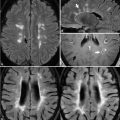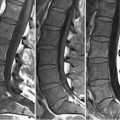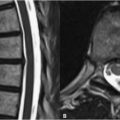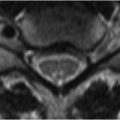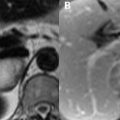29 Congenital Abnormalities Congenital posterior fossa abnormalities are frequently visualized on cervical spine MRI, often with accompanying neural axis and osseous findings. Sagittal images best evaluate the position of the cerebellar tonsils, which may normally lie as far as 5 mm below the foramen magnum. Extension of the tonsils below this level is seen in type 1 Chiari malformations, which are commonly asymptomatic. A symptomatic case—with the lack of space surrounding the medulla at the level of the foramen magnum leading to CSF obstruction—is demonstrated in Fig. 29.1A. Cerebellar herniation must be assessed with attention to tonsillar location relative to the anterior and posterior arches (arrows) of C1, as well as the foramen magnum. The tonsils frequently appear pointed in a type 1 malformation in contrast to their normal globular appearance. Clinical symptoms may also be due to the presence of hydromyelia, illustrated in addition in Fig. 29.1A. Hydromyelia occurs secondary to dilatation of the central canal of the spinal cord and thus appears on MRI as an area of CSF SI within an enlarged cord. Cord wall thinning (posteriorly in Fig. 29.1A) may occur in severe cases. Hydromyelia may occur at any location within the cord but favors the cervicothoracic junction when associated with Chiari malformations. With severe hydromyelia, the walls of the cord are markedly thinned and compressed against the adjacent dura. Intraspinal arachnoid cysts are a differential consideration but are quite rare. Hydromyelia involving the medulla is termed syringobulbia and is often symptomatic. The preservation of the 4th ventricle and the normal appearing midbrain colliculi help distinguish the Chiari 1 malformation of Fig. 29.1A from the type 2 malformation illustrated in Fig. 29.1B
![]()
Stay updated, free articles. Join our Telegram channel

Full access? Get Clinical Tree


